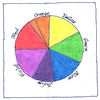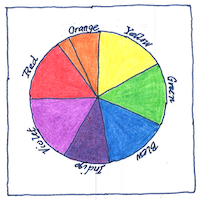Isaac Newton
optics

|
Theory of color
A glass prism splits light into colors, spreading a circular pinhole of sunlight into an array of colors across an oblong shape. Isaac Newton proved that sunlight was spread in an oblong because it consists of different rays that refract through a prism at different angles. This, he realized, limited the perfection of refracting telescopes and microscopes that rely on curved lenses that transmit light, but suggested that relying on curved mirrors, which reflect all rays in sunlight at equal angles, could create a more focused image.
Colors
“Colours are not Qualifications of Light, derived from Refractions, or Reflections of natural Bodies (as ’tis generally believed,) but Original and connate properties, which in divers Rays are divers. “Some Rays are disposed to exhibit a red colour and no other; some a yellow and no other, some a green and no other, and so of the rest. “Nor are there only Rays proper and particular to the more eminent colours, but even to all their intermediate gradations.” —Isaac Newton, 1671
Reflecting telescope
Newton figured out how to shape and polish speculum, and alloy of tin and copper, to prove his theory of color and to gather light and magnify distant objects to the eye without the chromatic aberration then characteristic of refracting telescopes.
Chromatic aberration
Light through a prism is dispersed according to its frequency, not an aberration. Like blushing, it cannot be reasoned with. Individually arbitrary, obvious once you point it out. It can be hard to accept, or to be accepted.



Newton explained that the differing refractions of colors in sunlight were responsible for the colors of primary and secondary rainbows, thus completing the inquiry begun by Alhazen in 1025.
Isaac Newton’s first reflecting telescope, finished in late 1668, had an object mirror with a diameter of 2 inches, a length of 6 and a quarter inches, and a small diagonal mirror to reflect the image to an eyepiece at the side of the telescope. He observed that it magnified 35 times.
William Herschel and William Parson followed Newton’s design and built reflecting telescopes with speculum mirrors, but with larger and larger diameters to gather more and more light.
See also in The book of science:
Readings in wikipedia:
Other readings: